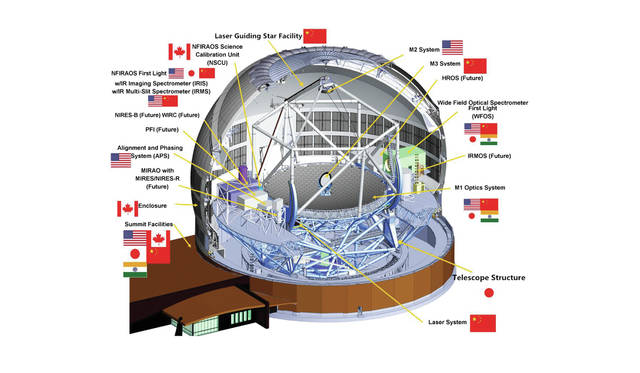While it remains to be seen where the Thirty Meter Telescope will be built, manufacturing of key components continues around the world.
Gary Sanders, project manager, said only manufacturing of the telescope enclosure and the structure that will contain the mirrors and instruments remain paused.
“Some of the heavy construction is on hold,” he told the Tribune-Herald. “Almost everything else is going ahead quite briskly.”
The TMT International Observatory board of directors, representing the five partner countries, is expected to decide in April whether to stay in Hawaii or move to Spain’s Canary Islands.
The nonprofit organization based in California says Maunakea remains the preferred location for its cutting-edge telescope, though several years of delays from protests and legal challenges have made its future here uncertain. Appeals of its sublease and land use permit are being heard by the state Supreme Court.
Sanders said the $1.4 billion project has received a land concession for a mountain on the island of La Palma and a hosting agreement. The environmental review process for that site should be done by the end of the year. He acknowledged the organization expects a legal challenge in Spain as well, though the project expects to prevail.
“There will undoubtedly be some legal challenge,” Sanders said, regarding the environmental impact statement. “It’s an environmentally sensitive place.”
The project completed an EIS for Maunakea in 2010 without challenges. Construction started in 2014 but was halted by protests prior to the state Supreme Court overturning its initial permit due to procedural violations by the Land Board.
The mountain is considered sacred by some Native Hawaiians.
The board granted another permit, which is under appeal, last year following a second contested case hearing.
Manufacturing of the dome is expected to begin later this year in Canada following confirmation of the site, Sanders said. Construction of the telescope structure will begin in April in Japan.
More than 250 people are working on the project worldwide, according to TIO. If built in Hawaii, the telescope will employ about 140 people on Hawaii Island.
The telescope’s 30-meter-wide primary mirror, far larger than any existing telescope, will consist of 574 mirror segments. So far, 213 blank segments have been made in Japan.
Sanders said mirror manufacturing is shared by each partner, which includes Japan, China, India and Canada, in addition to the University of California and Caltech.
At this point, the telescope is projected to reach first light in 2028, plus or minus a year, Sanders said.
He pegged the project at 15 percent complete but noted the organization is ready to ramp up once a site is known.
“The speed will go up,” Sanders said. “You climb a curve that’s sort of like a flat S. You go slow for awhile and then it’s steep. We’re ready to climb the steep part of the curve.”
As for the design, few things need to be changed to build in La Palma versus Maunakea, though the latter is considered a superior site for science, he said.
While TIO is trying to regain its sublease and land use permit in Hawaii, it hasn’t stopped contributions to educational and workforce development programs on the island.
The organization is the main supporter of the Akamai internship program, which helps Hawaii students find careers in science and engineering fields, and is increasing its contributions this year to add 10 more students to the program, said Sandra Dawson, TIO community affairs manager.
Additionally, it provides $1 million a year for educational programs on the island through The Hawaii Island New Knowledge, or THINK, Fund it established.
“I really feel this is the kind of thing a project like us should be doing,” Sanders said.
The project also hosts workshops for students from Hawaii and the other partner countries to allow them to contribute to the telescope and lay the groundwork for handing the reins to the next generation of scientists and engineers, he said.
“I’m not building this thing for me, it’s for you,” Sanders said he tells the students.
“I feel like we got to do it for them.”
If built in Hawaii, he said he wants to continue to build on local workforce initiatives, including incubating new businesses on the island to support TMT and other telescopes.
Email Tom Callis at tcallis@hawaiitribune-herald.com.

